This German Goulash Recipe Will Have You Returning For More!
If you’re looking for a thick and hearty beef stew, you’ve got to make this German Goulash.
Made with thick-cut stewing beef and fresh vegetables like carrots and celery, this authentic German goulash recipe makes good use of a little red wine in the delicious broth!
This German beef goulash is a versatile dish. You can enjoy German goulash with spaetzle, semmelknödel (bread dumplings), potatoes, or other noodles (e.g. fusilli pasta).
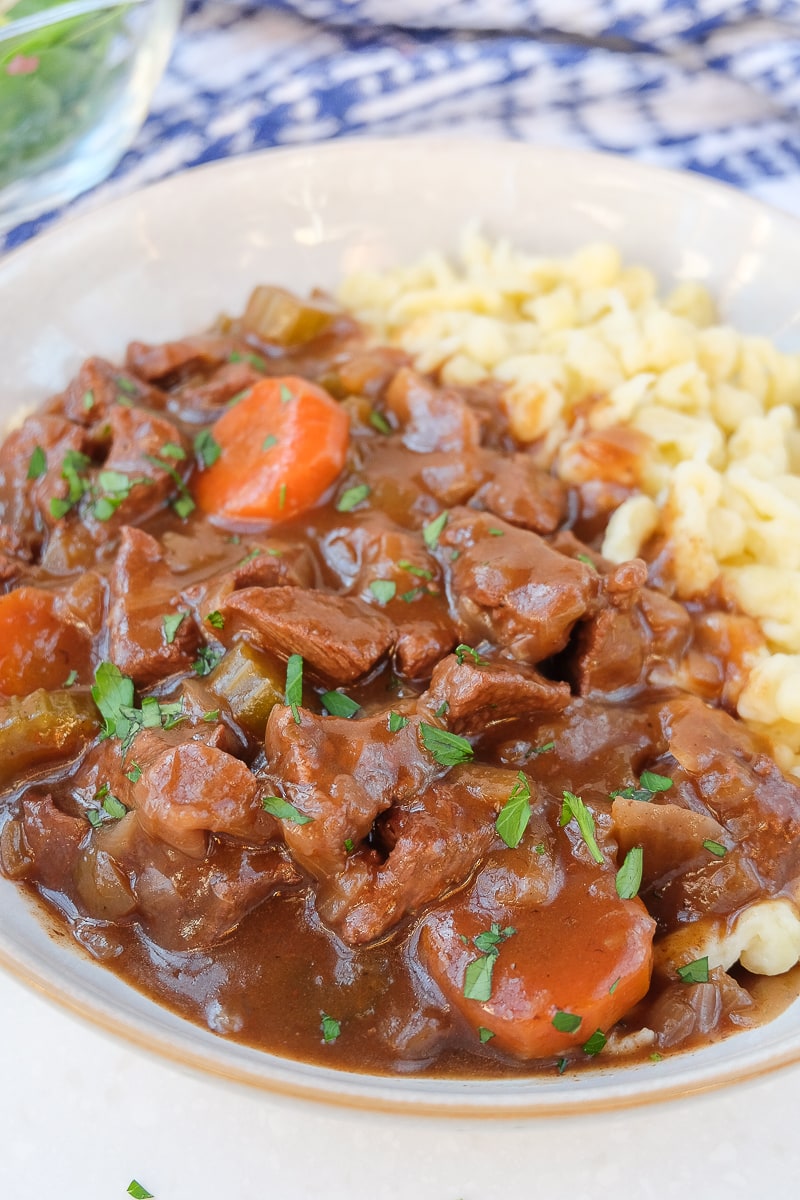
Different Versions Of Goulash
We’re big fans of all kinds of goulash since it’s something we both grew up eating.
Although goulash originated in Hungary, nowadays there are lots of different goulash variations across Central and Eastern European countries.
Even within a countries, there are often lots of different versions of this popular beef dish.
In Lisa’s family, the German goulash is more like a stew with a thicker consistency. Her family usually enjoys it with Spaetzle and the goulash itself doesn’t have potatoes in it.
This is in contrast to Eric’s family’s Hungarian Goulash. This version is thinner in consistency (it’s a soup) and has potatoes in the soup.
Some people like to add bell pepper to their goulash, while others don’t use red wine or a thickening agent (like corn starch).
In general, though, goulash in Europe is made with beef that is cut into small cubes. This is in contrast to the American version of goulash where ground beef is cooked with elbow macaroni.
As you can see, there are lots of different versions of goulash out there and we’re sure you’ll find a recipe that suits your taste!
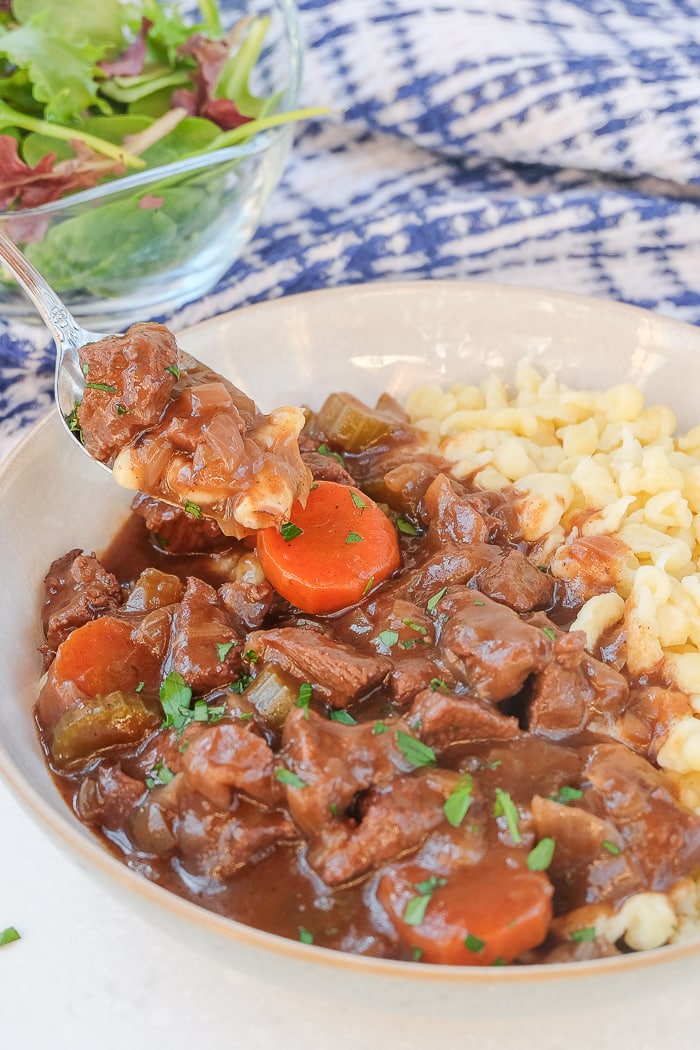
How to Make German Goulash – Step by Step Recipe Instructions
If you want to make authentic German goulash, then you can follow the Goulash recipe card at the bottom of this post for exact measurement.
And in case you’d like to see each step of the process, you can check out the recipe process photos below. This way, you can compare your goulash to ours each step of the way!
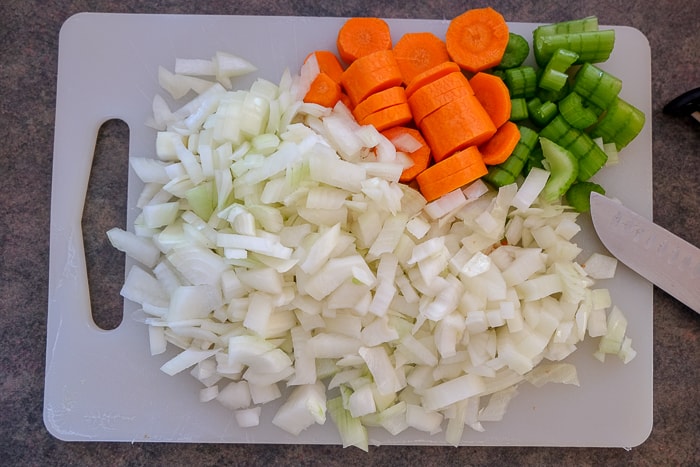
Start by peeling your onions and cutting them into small cubes.
You might think that three onions is a bit much – but they will boil down when simmering. They help thickening the broth and give it extra flavor.
Also peel the carrot and wash the celery stick. Then cut both into slices. If you like having lots of vegetables in your goulash, feel free to add more.
On the other hand, if you don’t like that many vegetables in your goulash, you can reduce it by some. However, we would recommend adding at least a small carrot and a celery stick for the flavor.
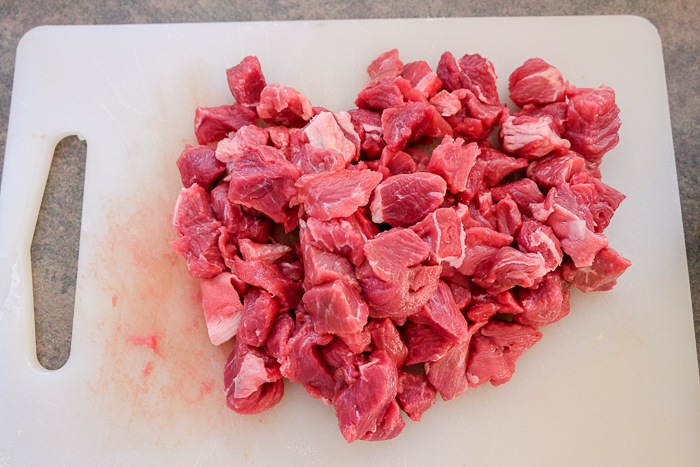
Also cut the stewing beef into approx. 3/4 inch cubes. Our goulash contains relatively little meat compared to some other recipes since for us it is mainly a side eaten with filling noodles or dumplings.
So feel free to adjust the amount of meat you use – just remember to adjust spices and broth accordingly as well.
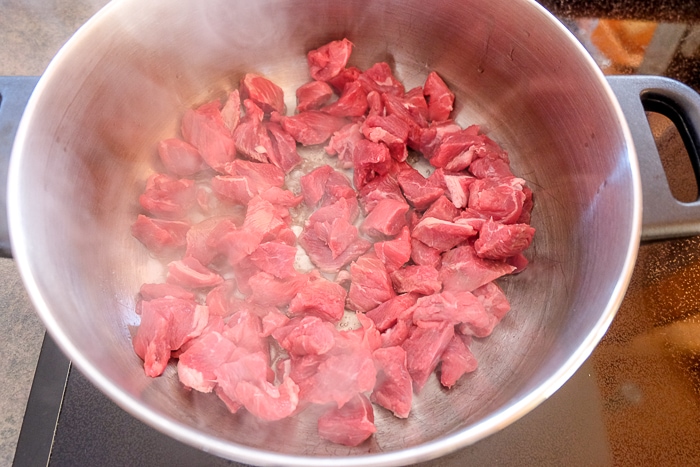
Melt some butter or oil in a large pot and fry the beef on high heat for a few minutes until the outsides appear to be cooked (there can still be some raw meat shining through).
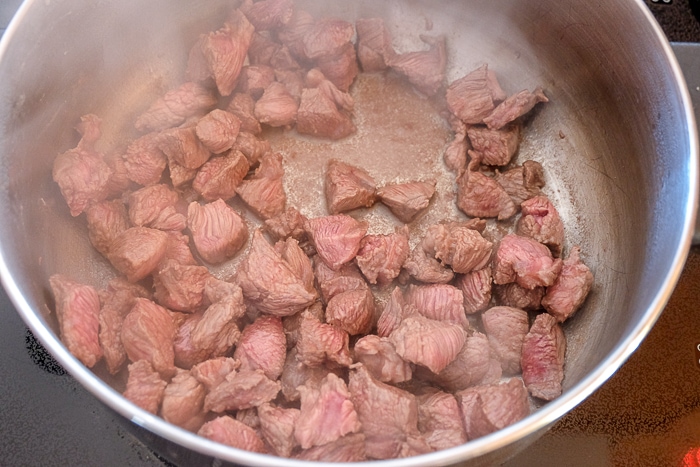
If you want some extra flavor, you can also fully sear it until the outside has a browned crust.
We don’t usually do that since we want our beef to be extra tender later, but we know some people prefer it this way.
Either way, don’t forget to stir regularly. Once the meat has browned to your liking, remove it from the pot and place it into a bowl for now.
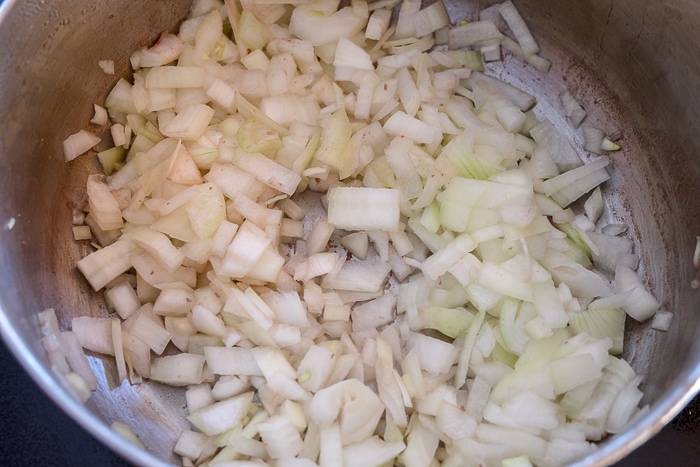
Now add the onions to the large pot and sauté them until translucent or lightly brown.
Once again, that’s a personal preference – browned onions usually mean more flavor.
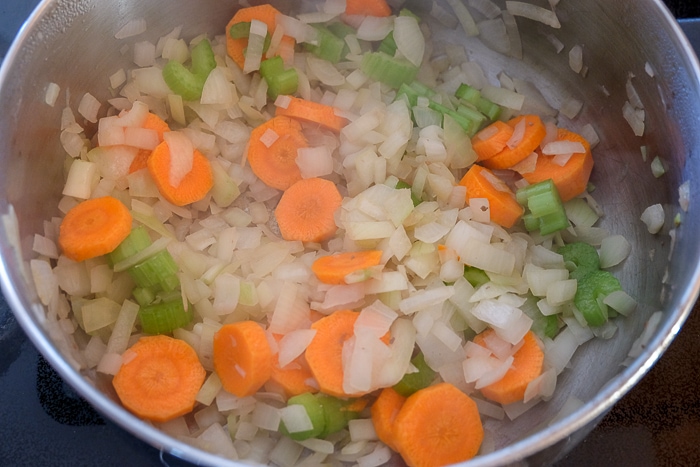
Then add the carrot and celery slices and sauté them for a few minutes as well. Remember to stir regularly.
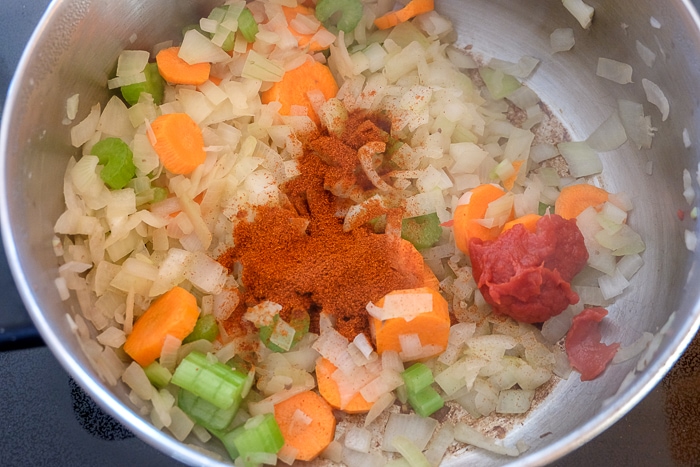
Now add the paprika powder, tomato paste, and a pinch of sugar. Mix well and cook them on medium-heat for a minute as well.
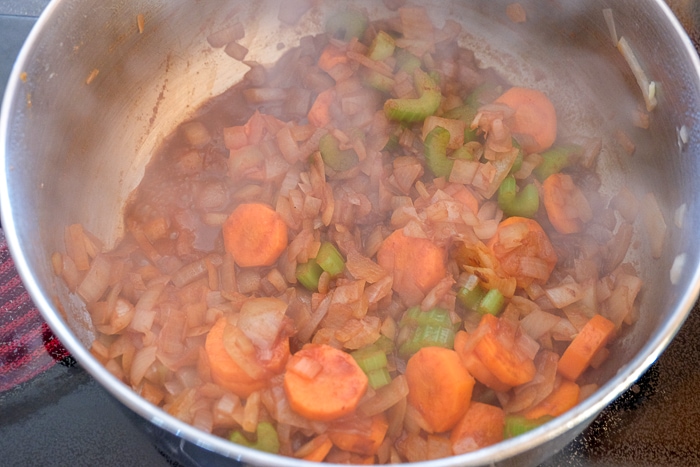
Next, add the red wine in three increments (so 1/3 cup at a time). Add some wine, stir it in, then wait until the liquid has reduced noticeably.
We’d recommend using a red wine that you’d also drink – aka a decent quality once – since it will have a noticable impact on the flavor.
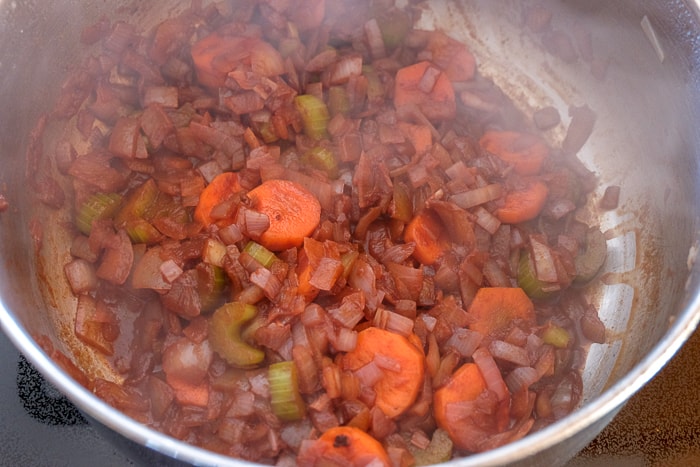
Then add some more wine. Repeat until you have used up the whole cup of wine. Stir regularly and wait until the liquid has reduced.
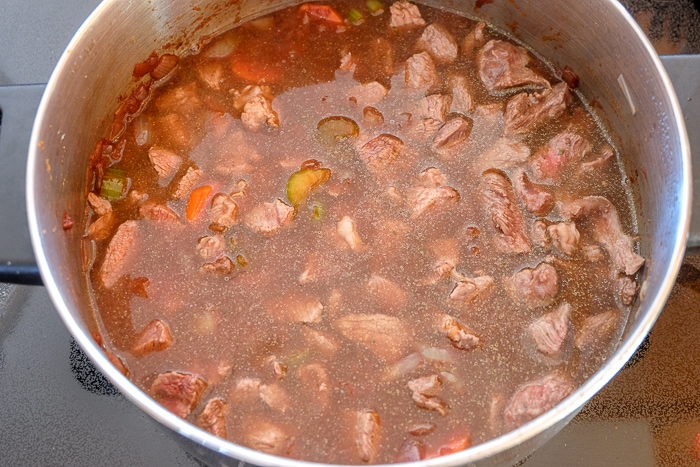
Now re-add the beef to the pot, give everything a stir, and add enough beef broth so that it just covers the contents in the pot.
For us that is usually between 1 1/2 – 2 cups of broth, but it might vary slightly for you.
Make sure to use a good-quality broth as this will significantly impact the flavor.
Bring the broth to a boil, then turn down the heat to low and add the lid. Let the goulash simmer on low for around 2 hours until the beef is very tender.
Stir regularly (but not too often since you don’t want the beef to fall apart) and add more broth as necessary. We don’t usually have to add more broth but depending on your pot and how much steam is evaporating, you might have to.
When you are happy with the tenderness of the meat, add salt and pepper to taste.
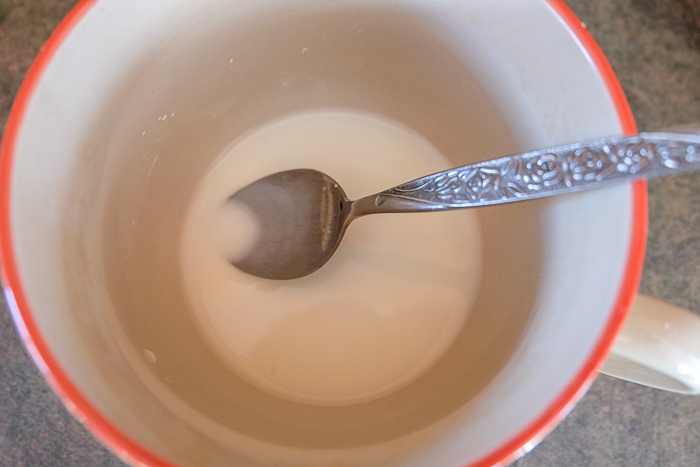
If you want the broth to be thicker, dissolve approx. 2 tablespoons of cornstarch in a little bit of cold water in a mug. This is completely optional though.
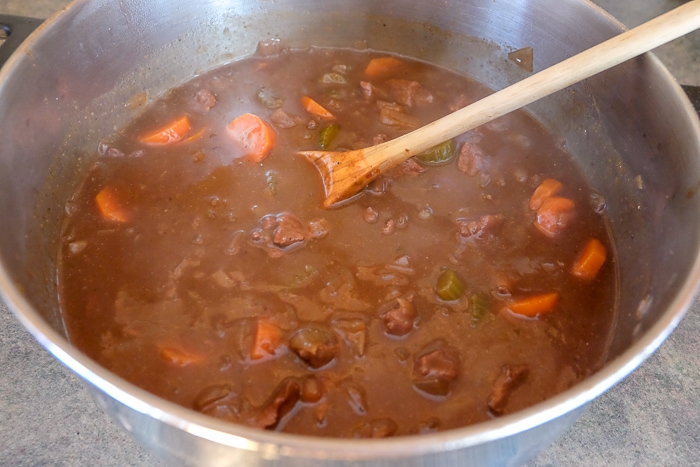
Add the mixture to the pot with the goulash and stir regularly while the broth is simmering until it has thickened.
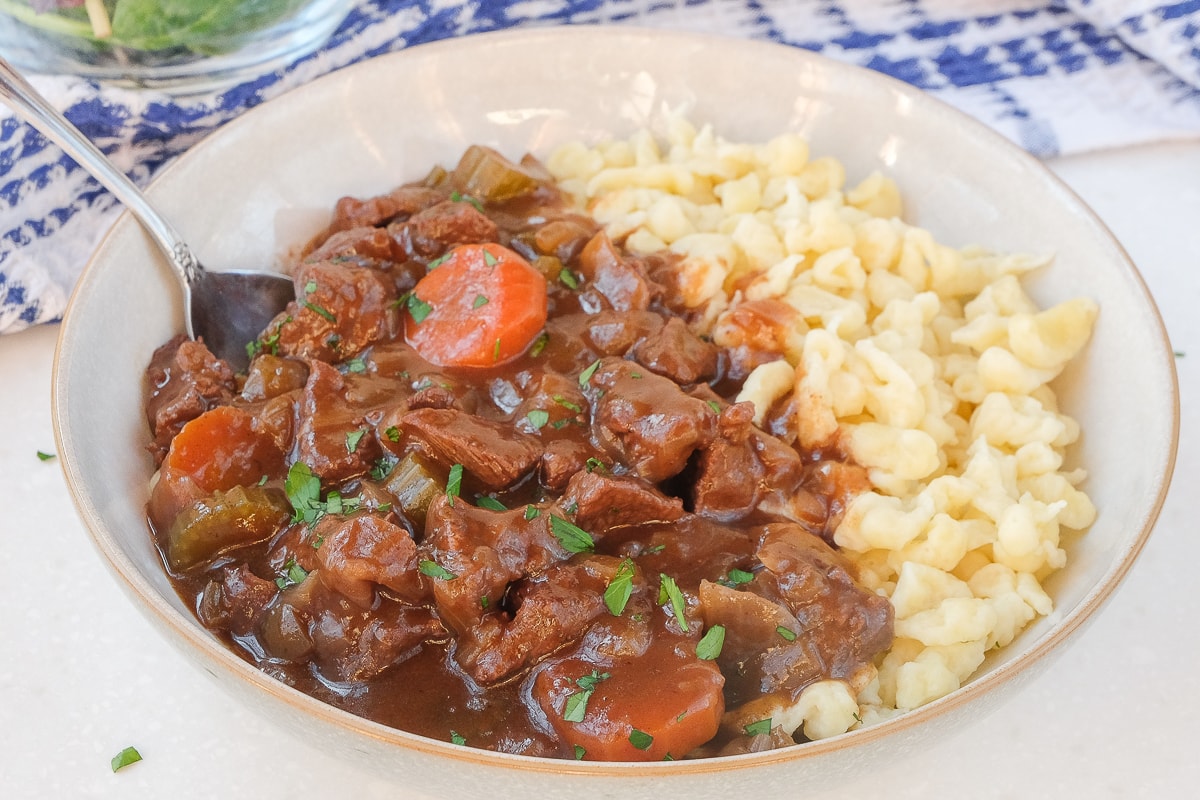
You can serve your goulash with spaetzle (or other pasta like fusilli), potatoes, bred dumplings or fresh bread.
Storage Tips
Store any leftovers in an airtight container with a lid in the fridge. Consume within 2-3 days.
While goulash tastes great fresh, it is actually one of the dishes that can taste even better a day later.
Simply reheat the goulash in a pot on the stove. Depending on how much cornstarch you added when making it (if any), you might want to add a little bit more water when reheating.
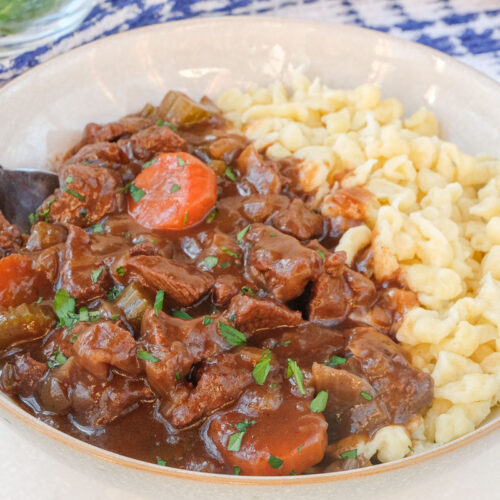
German Goulash
Ingredients
- 1 pound stewing beef
- 1 tablespoon oil or butter
- 3 medium-sized onions
- 1 carrot, optional
- 1 celery stick, optional
- 1 tablespoon tomato paste
- a pinch of sugar
- 2 teaspoons paprika
- 1 bay leaf, optional
- 1 cup red wine
- 1 1/2 – 2 cups beef broth
- salt and pepper to taste
- 2 tablespoons cornstarch, optional
Instructions
- Peel the onions and chop them into small pieces. Also, peel the carrot and wash the celery stick (optional). Cut the carrot and celery into slices.
- Cut the beef into approximately 3/4 inch cubes.
- In a large pot, melt some butter (or oil) and fry the beef on high heat for a few minutes until the outside appears to be cooked. If you want a more intense flavor, you can also fully sear the outsides. Stir regularly. Remove the beef from the pot and place the cubes into a bowl for now. Set the bowl aside.
- Add the onions to the large pot and sauté them until translucent (or lightly brown if preferred). Add the celery and carrot and sauté these vegetables for a few minutes as well.
- Now add the paprika, tomato paste, and a pinch of sugar. Mix well and cook on medium-high heat for a minute as well.
- Next, add the red wine in three increments – approx. 1/3 cup at a time. Add some wine, stir it in, and then wait until it has reduced noticeably. Then add some more wine and repeat until you have used up the whole cup.
- Re-add the beef to the pot, stir everything and then add enough beef broth so that it just covers the contents in the pot. In our case, this is usually between 1 1/2 – 2 cups of broth – it might vary slightly for you. At this stage, also add your bay leaf if you want some more flavor (optional).
- Bring the broth to a boil, then turn down the heat to low, add the lid and let the goulash simmer on low heat for around 2 hours until the meat is very tender. Stir occasionally and add more broth as necessary (we don’t usually need to do this).
- When you are happy with the tenderness of the meat, add salt and pepper to taste.
- Optional: Dissolve 2 tablespoons of cornstarch in a little bit of cold water in a separate mug. Add it to the pot with the goulash and stir regularly while simmering the broth until it has thickened.
- Serve your goulash with Spätzle (egg noodles), fusilli pasta, potatoes, bread dumplings, or fresh bread.
Notes
- This is how Lisa ate goulash in Germany growing up – there are many other versions as well. Some people like to add bell peppers, others don’t add any vegetables at all.
- It’s important that the beef simmers on low heat to make it tender. If the heat is too high, the meat might dry out and/or become tough and rubbery.
- We’d recommend using a good quality wine (one that you’d also drink) and beef broth since that will impact the taste of the goulash quite noticeably.
- Since for us, this goulash is mainly a side/sauce eaten with filling spaetzle or bread dumplings, it doesn’t contain as much meat as some other goulash recipes. You can always add more beef than just one pound if desired.
- You don’t have to add cornstarch at the end to thicken the broth. This is just what we do since Lisa always likes her German goulash to be quite thick and she ate it this way growing up in Germany.
Nutrition
This nutritional information has been estimated by an online nutrition calculator. It should only be seen as a rough calculation and not a replacement for professional dietary advice.
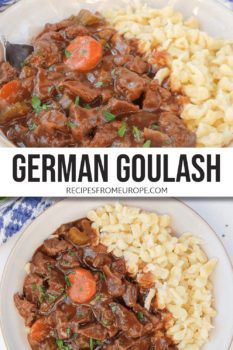
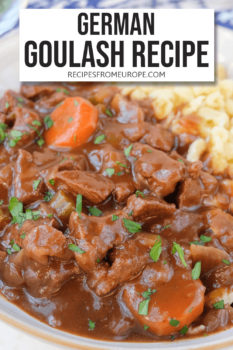

This sounds delicious. I am Hungarian and German so I eaten this both ways. I prefer the thicker version. Question, could you cook this in a dutch oven and use beef short ribs???
Sorry for the late reply Lisa! I haven’t made it in a dutch oven yet but it should work. The cooking time might be slightly different but you can always try the meat to see if it is tender. Beef short ribs are actually great for slow cooking and can be very flavorful. /Lisa
Hoping it’s ok with Lisa but I added dry mustard, Old Bay seasoning and a couple shakes of red pepper flakes at the end. This recipe was so delicious, I didn’t have leftovers.
Thanks for sharing Karen, sounds tasty! I also love experimenting with recipes to see how I can change them.
When we lived overseas, I’d buy the Knorr Gulasch packet and my son decided German gulasch was his favorite meal. I was so happy to find your recipe, which is far better than the packet. The first time I made it, my son ate the whole thing before anyone else could try it.
That makes us SO happy to hear. Thank you so much for sharing! /Lisa
Delicious
Wonderful